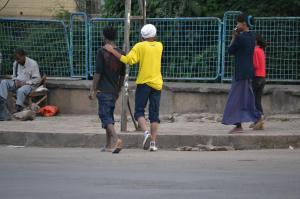My last day in Addis Ababa. This trip was my third visit to the Ethiopian capital, as I noted in the previous post. It took me this long to notice something that I seem to have completely something about Ethiopian people during the two previous occasions I was here.
I missed how much Ethiopians seem to like body contact with each other. The people like touching each other, walking while hugging, with entwined hands, or in an embrace.
It is not unanticipated for a married couple or people who appear to be in a sexual relationship to walk hand in hand on a street. The predominance of such behaviour differs from culture to culture, needless to say. However, one can imagine that in most cultures couples more than non-couples will display public affection.
The same goes for parents and children: we tend to expect adults to hold young ones’ hands when crossing a street.
However, a man walking the streets while hugging another man? Two women with hands entwined as they walk down a street? These are unexpected public behaviours. They must have something to do with Ethiopian culture and traditions.
It is incredible that I had not noticed this before. My attention was absorbed by other matter in 2011 when I was here, perhaps. The moment I noticed it, everywhere I turned it has been visible.
On every street I walk, persons are walking side by side with each other with an arm thrown over the other’s shoulder. They walk holding each other’s hands on the streets of Addis, almost unconsciously I think. I see them standing waiting for a taxi with an arm around each other waist. It is not only men walking in an embrace with women. Men walk while hugging each other. Women are holding hands with each other. The former was less expected than the latter. I think that compared to heterosexual African men, women in many African cultures are likely to feel more comfortable with body contact with other women. I imagine that in streets of South Africa, for example, it is common for female friends are likelier than male friends to hold hands while walking together. It might be that there are some differences between rural and urban parts of the country, but that this is true in general.
I confess that the first time I noticed two men walking together in an embrace I misread what I was observing. My immediate interpretation of the ‘couple’ was that Addis Ababa is fantastically gay-friendly. I thought to myself, how come I have not heard about how queer the Ethiopia. Almost immediately though, I realised that there were several other ‘gay, lesbian, and/or hetero couples’ in all directions my eyes turned. This couldn’t be primarily about sexuality. It had to be about culture.
When I told my colleagues from Unisa I am here with about how much Ethiopians seem to like being in body contact with each other, one of them said that she had made a similar observation. She said that the first time she saw how many women were walking arm in arm on the streets of the city she had thought ‘what a lot sister Ethiopia has’. I had said nothing to her and the other colleagues about what I had thought to myself the first time I noticed the phenomenon. I don’t know whether the others had noticed the behaviour. No one else commented on it.
Perhaps it was only surprising to the two of us. It could be that the others in our group are used to seeing individuals across and within the sexes as comfortable with body contact as Ethiopians appear to be.
I doubt it though. It might be that they are uncomfortable with body contact themselves or talking about such behaviour. Let me not be ungenerous. Perhaps, given that we have health scholars, physicists, environmental scientists and educationists among us, this is not as interesting to others as behavioural scientists might feel it is. And I think it is terribly interesting, for so many reasons.
How did this behaviour develop? What is its purpose? Is it confined to Addis Ababa or is observable throughout Ethiopia?
From now on, I plan to make observations about how common or uncommon this behaviour in the places I visit.

Interesting observation. For us, what you observed is not even noticed by us until recently when outsiders started to point out that we have “too much” body contact. It comes of naturally that we hug and hold hands, not only in Addis Ababa but throughout the country. I guess we Ethiopians are warm people. In fact you see less of it in Addis because young people are increasingly exposed to western media and interpret those gestures in western mindset. Otherwise, men hugging men, ladies with arms interlocked is perfectly fine, friendly brotherly love, nothing sexual at all.
Yes, I noticed that touching was common in many parts of Ethiopia when we drove from Hawassa to Gondar. For me it is one of the most ‘touching’, beautiful and attractive aspects of the society. I think it deserves studying and writing whole books on. Truth is I wish that it was common in other parts of the continent, when men touch only when they fight, but know that it is near impossible to learn when one’s society discourages it. Thanks.